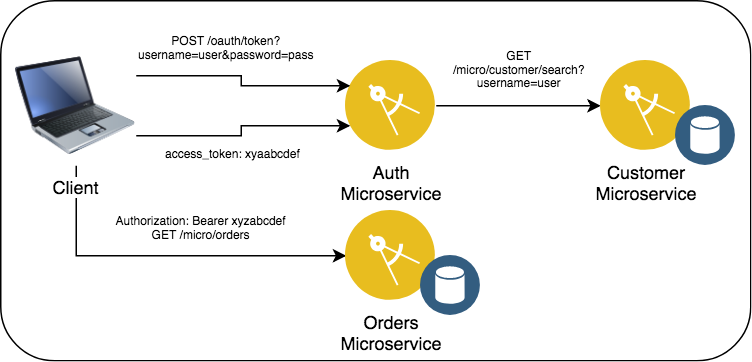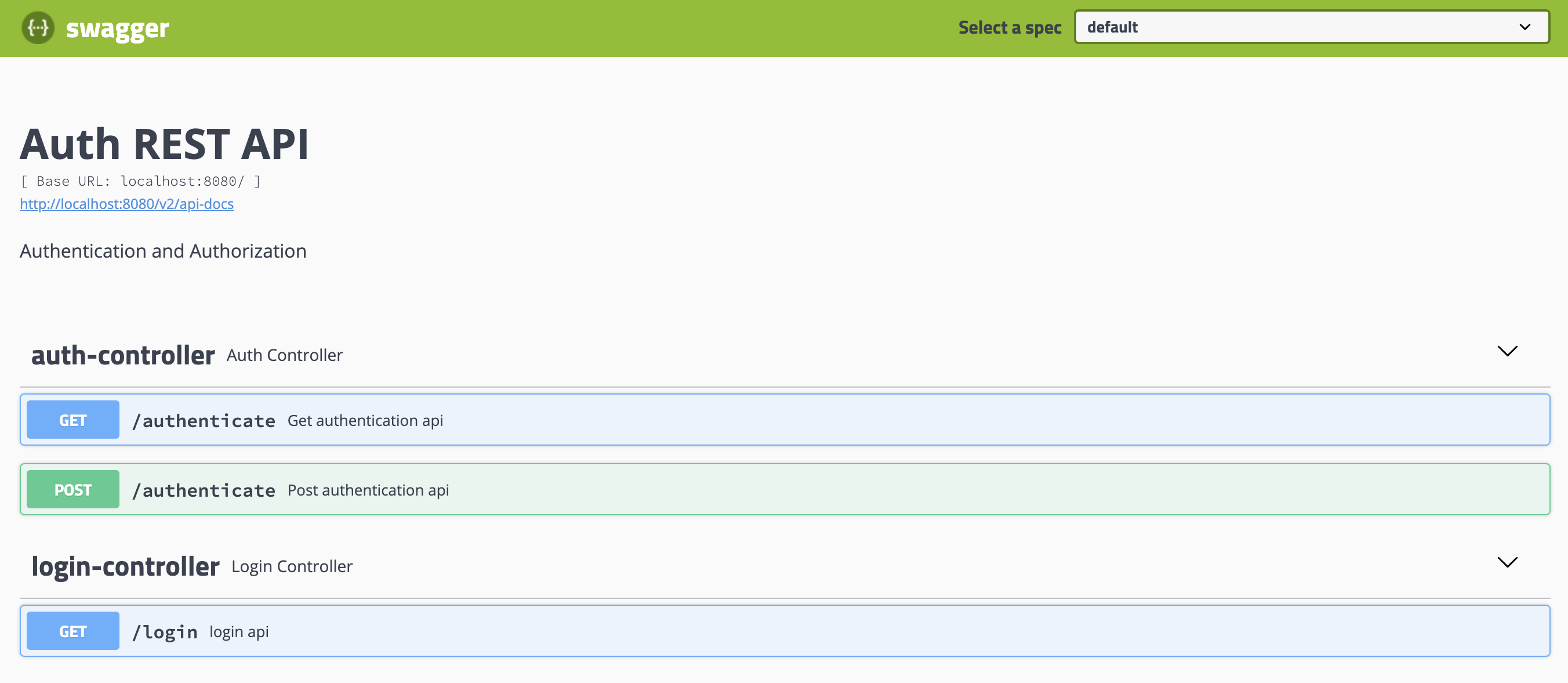This project is part of the 'IBM Cloud Native Reference Architecture' suite, available at https://cloudnativereference.dev/
This project demonstrates how to authenticate the API user as well as enable OAuth 2.0 authorization for all OAuth protected APIs in the Storefront reference application.
- When a client wishes to acquire an OAuth token to call a protected API, it calls the OAuth Provider (Authorization microservice) token endpoint with the
username/passwordof the user and requests a token with scopeblue. - Authorization microservice will call the Customer microservice to get the credentials and perform the validation.
- If the
username/passwordare valid,HTTP 200is returned, along with a JWT (signed using a HS256 shared secret) in the JSON response underaccess_tokenwhich contains the auth ID of the user passed in theuser_nameclaim. - The client uses the JWT in the
Authorizationheader as a bearer token to call other Resource Servers that have OAuth protected API (such as the Orders microservice). - The service implementing the REST API verifies that the JWT is valid and signed using the shared secret, then extracts the
user_nameclaim from the JWT to identify the caller. - The JWT is encoded with scope
blueand the the expiry time inexp; once the token is generated, there is no additional interaction between the Resource Server and the OAuth server.
Here is an overview of the project's features:
- Leverage
Spring Bootframework to build a Microservices application. - Uses
Spring Security OAuth. - Return a signed JWT Bearer token back to caller for identity propagation and authorization
- Uses
Dockerto package application binary and its dependencies.
Following the OAuth 2.0 specification, the Authorization server exposes both an authorization URI and a token URI.
- GET
/oauth/authorize - POST
/oauth/token
The Storefront reference application supports the following clients and grant types:
- The Storefront UI is using client ID
bluecomputeweband client secretbluecomputewebs3cretsupporting OAuth 2.0 Password grant type.
The Storefront application has scope, blue.
-
- Installing on MacOS
- Installing on Windows
- Installing on RHEL
- Installing on Ubuntu For more details on installation, check this out.
-
Docker Desktop
We created a new spring boot project using appsody as follows.
appsody repo add kabanero https://github.com/kabanero-io/kabanero-stack-hub/releases/download/0.6.5/kabanero-stack-hub-index.yaml
appsody init kabanero/java-spring-boot2
And then we defined the necessary code for the application on top on this template.
- Clone auth repository:
git clone https://github.com/ibm-garage-ref-storefront/auth-ms-spring.git
cd auth-ms-spring- Before running the application, make sure you grab the
HS256shared secret.
To make things easier for you, we pasted below the 2048-bit secret here.
E6526VJkKYhyTFRFMC0pTECpHcZ7TGcq8pKsVVgz9KtESVpheEO284qKzfzg8HpWNBPeHOxNGlyudUHi6i8tFQJXC8PiI48RUpMh23vPDLGD35pCM0417gf58z5xlmRNii56fwRCmIhhV7hDsm3KO2jRv4EBVz7HrYbzFeqI45CaStkMYNipzSm2duuer7zRdMjEKIdqsby0JfpQpykHmC5L6hxkX0BT7XWqztTr6xHCwqst26O0g8r7bXSYjp4a
- To run the auth application, use the below command.
appsody run --docker-options "-e HS256_KEY=<Paste HS256 key here>"
- If it is successfully running, you will see something like below.
[Container] 2020-05-05 07:18:23.995 INFO 178 --- [ restartedMain] o.s.s.concurrent.ThreadPoolTaskExecutor : Initializing ExecutorService 'applicationTaskExecutor'
[Container] 2020-05-05 07:18:24.055 INFO 178 --- [ restartedMain] o.s.b.d.a.OptionalLiveReloadServer : LiveReload server is running on port 35729
[Container] 2020-05-05 07:18:24.108 INFO 178 --- [ restartedMain] o.s.b.a.w.s.WelcomePageHandlerMapping : Adding welcome page: class path resource [public/index.html]
[Container] 2020-05-05 07:18:24.634 INFO 178 --- [ restartedMain] d.s.w.p.DocumentationPluginsBootstrapper : Context refreshed
[Container] 2020-05-05 07:18:24.680 INFO 178 --- [ restartedMain] d.s.w.p.DocumentationPluginsBootstrapper : Found 1 custom documentation plugin(s)
[Container] 2020-05-05 07:18:24.751 INFO 178 --- [ restartedMain] s.d.s.w.s.ApiListingReferenceScanner : Scanning for api listing references
[Container] 2020-05-05 07:18:24.926 INFO 178 --- [ restartedMain] o.s.b.w.embedded.tomcat.TomcatWebServer : Tomcat started on port(s): 8080 (http) with context path ''
[Container] 2020-05-05 07:18:24.934 INFO 178 --- [ restartedMain] application.Main : Started Main in 10.296 seconds (JVM running for 12.632)
- You can also verify it as follows.
$ docker ps
CONTAINER ID IMAGE COMMAND CREATED STATUS PORTS NAMES
cc1cc3d65ff7 kabanero/java-spring-boot2:0.3 "/.appsody/appsody-c…" 2 minutes ago Up 2 minutes 0.0.0.0:5005->5005/tcp, 0.0.0.0:8080->8080/tcp, 0.0.0.0:8443->8443/tcp, 0.0.0.0:35729->35729/tcp auth-ms-spring
Now, you can validate the application as follows.
curl -i \
-X POST \
-u bluecomputeweb:bluecomputewebs3cret \
http://localhost:8080/oauth/token?grant_type=password\&username=user\&password=password\&scope=blue
If it is successful, you will see something like below.
$ curl -i -X POST -u bluecomputeweb:bluecomputewebs3cret http://localhost:8080/oauth/token?grant_type=password\&username=user\&password=password\&scope=blue
HTTP/1.1 200
Cache-Control: no-store
Pragma: no-cache
X-Content-Type-Options: nosniff
X-XSS-Protection: 1; mode=block
X-Frame-Options: DENY
Content-Type: application/json;charset=UTF-8
Transfer-Encoding: chunked
Date: Tue, 05 May 2020 07:23:15 GMT
{"access_token":"eyJhbGciOiJIUzI1NiIsInR5cCI6IkpXVCJ9.eyJleHAiOjE1ODg3MDY1OTUsInVzZXJfbmFtZSI6InVzZXIiLCJhdXRob3JpdGllcyI6WyJST0xFX1VTRVIiXSwianRpIjoiMTBmMmExNGMtOWZmNi00OWI5LWE4NzUtNGVjYzAwNjZkNmY0IiwiY2xpZW50X2lkIjoiYmx1ZWNvbXB1dGV3ZWIiLCJzY29wZSI6WyJibHVlIl19.2vzcyYbm6lYUv0iNl9B15uCBngIbcIsGs2ulC98sAds","token_type":"bearer","refresh_token":"eyJhbGciOiJIUzI1NiIsInR5cCI6IkpXVCJ9.eyJ1c2VyX25hbWUiOiJ1c2VyIiwic2NvcGUiOlsiYmx1ZSJdLCJhdGkiOiIxMGYyYTE0Yy05ZmY2LTQ5YjktYTg3NS00ZWNjMDA2NmQ2ZjQiLCJleHAiOjE1OTEyNTUzOTUsImF1dGhvcml0aWVzIjpbIlJPTEVfVVNFUiJdLCJqdGkiOiI0MmMyZjFhZS05NTAyLTQ3M2ItOTAwMy1iODc5NjE0MDFlMGMiLCJjbGllbnRfaWQiOiJibHVlY29tcHV0ZXdlYiJ9.P6eOlzoBk8-d0KKK_7725U0wICosO1G0SYPv8r62-uM","expires_in":43199,"scope":"blue","jti":"10f2a14c-9ff6-49b9-a875-4ecc0066d6f4"}
Originally, in the storefront application, this microservice will talk to customer microservice and validate the credentials. To make it easy for local validation, we enabled a test user which can be used to verify the functionality of this application.
- Also you can access the swagger ui at http://localhost:8080/swagger-ui.html
- We also enabled sonarqube as part of the application.
To run the sonarqube as a docker container, run the below command.
docker run -d --name sonarqube -p 9000:9000 sonarqube
To test the application, run the below command.
./mvnw sonar:sonar -Dsonar.login=admin -Dsonar.password=admin
Now, access http://localhost:9000/, login using the credentials admin/admin, and then you will see something like below.
- We included contract testing as part of our application too.
To run Pact as a docker container, run the below command.
cd pact_docker/
docker-compose up -d
To publish the pacts to pacts broker, run the below command.
./mvnw clean install pact:publish -Dpact.broker.url=http://localhost:8500 -Ppact-consumer
To verify the results, run the below command.
./mvnw test -Dpact.verifier.publishResults='true' -Dpactbroker.host=localhost -Dpactbroker.port=8500 -Ppact-producer
Now you can access the pact broker to see if the tests are successful at http://localhost:8500/.
To exit the application, just press Ctrl+C.
It shows you something like below.
^CRunning command: docker stop auth-ms-spring
[Container] 2020-05-05 07:31:39.015 INFO 178 --- [ Thread-16] o.s.s.concurrent.ThreadPoolTaskExecutor : Shutting down ExecutorService 'applicationTaskExecutor'
[Container] [INFO] ------------------------------------------------------------------------
[Container] [INFO] BUILD SUCCESS
[Container] [INFO] ------------------------------------------------------------------------
[Container] [INFO] Total time: 13:47 min
[Container] [INFO] Finished at: 2020-05-05T07:31:39Z
[Container] [INFO] ------------------------------------------------------------------------
Closing down development environment.
You have successfully deployed and tested the Auth Microservice in local Docker Containers using Appsody.
To see the Auth application working in a more complex microservices use case, checkout our Microservice Reference Architecture Application here.




